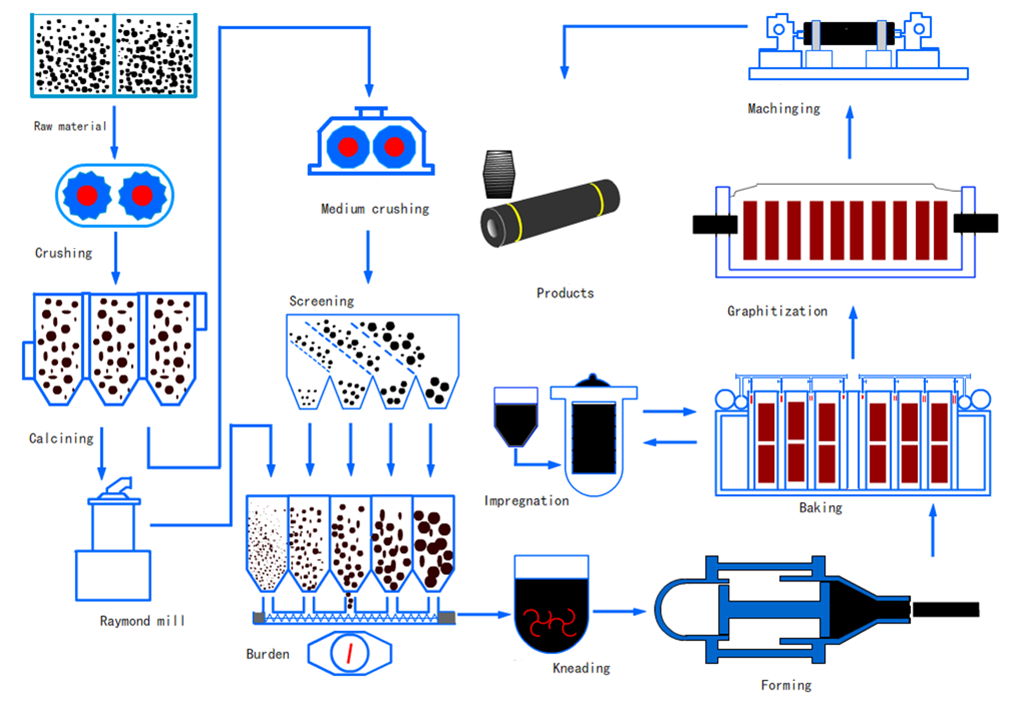
Graphite electrode is a high temperature resistant graphite conductive material produced by petroleum knead, needle coke as aggregate and coal bitumen as binder, which are produced through a series of processes such as kneading, molding, roasting, impregnation, graphitization and mechanical processing.
The graphite electrode is an important high-temperature conductive material for electric steelmaking. The graphite electrode is used to input electric energy to the electric furnace, and the high temperature generated by the arc between the electrode end and the charge is used as a heat source to melt the charge for steel making. Other ore furnaces that smelt materials such as yellow phosphorus, industrial silicon, and abrasives also use graphite electrodes as conductive materials. The excellent and special physical and chemical properties of graphite electrodes are also widely used in other industrial sectors.
Calcination: The carbonaceous raw material is heat-treated at a high temperature to discharge the moisture and volatile matter contained therein, and the production process corresponding to the improvement of the original cooking performance is called calcination. Calcination makes profound changes in the structure and physicochemical properties of carbonaceous raw materials, mainly in improving the density, mechanical strength and electrical conductivity of coke, improving the chemical stability and oxidation resistance of coke, laying a foundation for the subsequent process.
Raw material crushing and ingredients: Before the batching, the bulk calcined petroleum coke and needle coke must be crushed, ground, and sieved. The medium crushing is usually carried out by crushing equipment of about 50 mm through a jaw crusher, a hammer crusher, a roll crusher and the like to further crush the 0.5-20 mm size material required for the batching. Milling is a process in which a carbonaceous material is ground to a graphite powder having a particle diameter of 0.15 mm or less by a mill or the like. Screening is a process in which a wide range of materials after a crushing is divided into several particle size ranges with a narrow range of sizes through a series of sieves with uniform openings. Current electrode production usually requires 4-5 pellets and 1-2 powder grades. Ingredients are the production processes for calculating, weighing and focusing the various aggregates of aggregates and powders and binders according to the formulation requirements.
Kneading: Mixing and quantifying various particle size carbonaceous granules and powders with a certain amount of binder at a certain temperature, and kneading the plasticity paste into a process called kneading.
Molding: The molding of carbon material refers to the process of plastically deforming the kneaded carbon paste under the external force applied by the molding equipment to finally form a green body (or raw product) having a certain shape, size, density and strength process.
Calcination: It is a process in which the carbon product green body is filled in a specially designed heating furnace under the protection of the filler to perform high-temperature heat treatment to carbonize the coal pitch in the green body.
Impregnation: A process in which a carbon material is placed in a pressure vessel and the liquid impregnant pitch is immersed in the pores of the product electrode under certain temperature and pressure conditions.
Graphitization: refers to the high-temperature heat treatment process in which the carbon product is heated to 2300 °C or more in a protective medium in a high-temperature electric furnace to convert the amorphous layered structure carbon into a three-dimensional ordered graphite crystal structure.
Machining: The purpose of mechanical machining of carbon graphite materials is to achieve the required size, shape, precision, etc. by cutting to make the electrode body and joints in accordance with the requirements of use.
We are professional graphite electrode supplier, share the graphite electrode production process with you.
